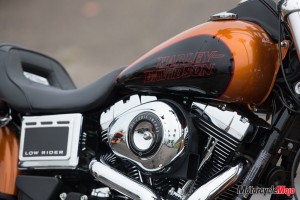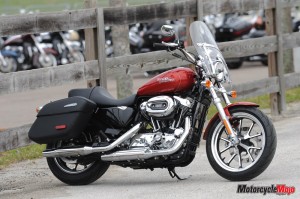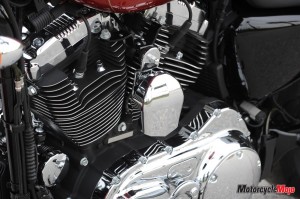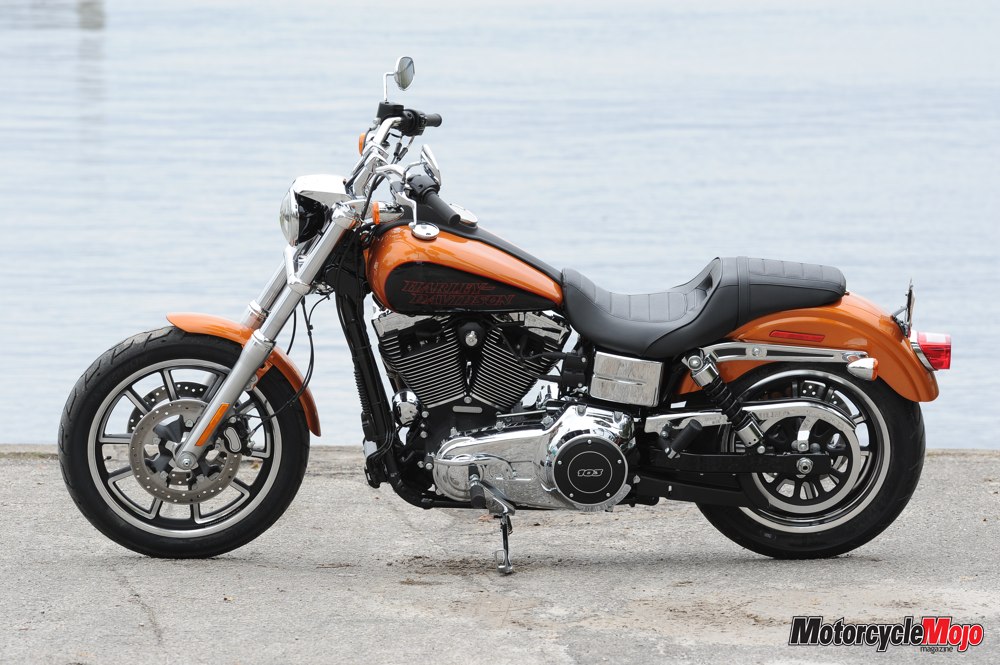Harley-Davidson releases two new models based on vintage styles
FXDL Low Rider
The modern cruiser can trace its roots directly back to the 1977 Harley-Davidson Low Rider. During Harley’s AMF years (1969–81), there really weren’t many models to choose from: a pair of Sportsters, the Super Glide and a couple of FLH touring bikes. The FXS Low Rider was introduced to capitalize on the custom-bike craze of the early seventies and earned its name due to its low, 27-inch seat height. It also boasted some styling features usually reserved for custom bikes, including a flat, drag-style handlebar set on dog-bone risers, a two-into-one exhaust, and factory-installed highway pegs. A massive primary case connected the 1200 cc Shovelhead V-twin to a four-speed transmission, and it had electric and kick starting.
The Low Rider became instantly popular, transcending platforms and evolving from the rigid-mount FX frame to the rubber-mounted FXR in 1987, and then to the Dyna platform in 1995, also featuring rubber engine mounting. A year after introduction, its Shovelhead grew to 1340 cc and was replaced by the Evolution engine in 1984, before settling on the Twin Cam engine in ’99. The Low Rider remained in Harley’s line-up until 2009, when it was discontinued due to low interest, since there were so many other models to choose from. Well, the Low Rider is back for 2014, with styling cues that hark back to the original 1977 model.
 The new Low Rider is again built on a Dyna chassis, and it features a seat height of 680 mm, a hair lower than the original in ’77. The rubber engine mounting is designed to lessen, not to eliminate vibration, reducing it to a low-frequency throbbing. At idle, the engine shakes in the frame, transmitting a soothing, quaking vibration that dissipates into the chassis as you pick up speed. The source of the shaking is the latest version of the Twin-Cam 103, displacing 1690 cc and producing plentiful torque at low revs.
The new Low Rider is again built on a Dyna chassis, and it features a seat height of 680 mm, a hair lower than the original in ’77. The rubber engine mounting is designed to lessen, not to eliminate vibration, reducing it to a low-frequency throbbing. At idle, the engine shakes in the frame, transmitting a soothing, quaking vibration that dissipates into the chassis as you pick up speed. The source of the shaking is the latest version of the Twin-Cam 103, displacing 1690 cc and producing plentiful torque at low revs.
The resurgence of the Low Rider is part of Harley’s Project Rushmore, a project that oversaw many improvements to the company’s touring bikes late last year, including the new Twin-Cooled engine. However, the Twin-Cooled engine, which uses liquid-cooled cylinder heads, is not used in the Low Rider because there’s just no room to seamlessly integrate a radiator into the Low Rider’s fairing-less chassis.
Project Rushmore is responsible for a few comfort-enhancing improvements, though, including a seat with a removable bolster that moves the rider 40 mm forward. The pegs have been moved 50 mm forward from where they’re usually located on a Dyna, and although the dog bone–like risers of the original Low Rider have returned, they now pivot at the bottom, allowing you to swing the handlebar fore and aft over a 60 mm range. Reminiscent of the original Low Rider, the speedometer and tachometer are placed atop the 18-litre fuel tank.
Harley did a great job of remaining faithful to the original Low Rider look, and if you were to replace its stock pullback handlebar with a drag bar, and the front fender with an original strutted front fender, it would take more than just a glance to distinguish new from old. Even the tank graphics are faithful to the original, and the air filter is teardrop shaped, not unlike the S&S filter that riders used to replace the filter with on the original. Cast wheels are standard, with spoke wheels available as an option (though I prefer the look of the cast items on this bike), and they use tubeless tires.
The adjustable ergonomics are said to accommodate rider heights from five foot one to six foot one; I’m six feet tall and was very comfy with the seat bolster removed and the handlebar adjusted in the middle of its range. Foot pegs are a comfortable reach, and their slightly forward position puts your feet roughly where they’d be with floorboards, though you will not be able to move your feet around.
 When it comes to weather at Daytona, you should always assume that the forecast will be wrong. Three different news sources were forecasting highs of about 18 degrees Celsius around Daytona Beach, and the overcast morning skies were supposed to clear by noon with no chance of rain. The sky looked promising as morning temperatures hovered around 14 degrees, so I dressed in anticipation of the 18-degree high.
When it comes to weather at Daytona, you should always assume that the forecast will be wrong. Three different news sources were forecasting highs of about 18 degrees Celsius around Daytona Beach, and the overcast morning skies were supposed to clear by noon with no chance of rain. The sky looked promising as morning temperatures hovered around 14 degrees, so I dressed in anticipation of the 18-degree high.
It didn’t take long after leaving on our ride to realize that the relatively inviting weather forecasts were probably broadcast so that Bike Week attendees wouldn’t turn around and head home. Either that, or the weather forecasters in Florida have a very twisted sense of humour. Temperatures plummeted, and worse yet, it began to rain. The Sunshine State was anything but. Of course, the Low Rider’s lack of bodywork reminded me of Florida’s cruelly comical weather folk, as temperatures dropped from 14 degrees Celsius to six, where they remained for most of our ride.
The Low Rider’s transmission contains two more ratios than it did in ’77, and unlike that agricultural gearbox, which had canyon-like gaps between ratios and clanged so hard when shifting gears that it shattered windows, the FXDL’s transmission is light in operation and the ratios are well spaced. Gear ratios are almost irrelevant, though, because the engine is torquey enough to allow you to pull away from as low as 50 km/h in top gear. It’s a great engine that doesn’t rely on revs to generate enthusiastic acceleration, and it sounds good to boot.
Steering is lazy, though it easily holds a line and contributes to unwavering stability, and the suspension is quite compliant, but even a rigid setup would be considered compliant on Florida’s straight, flat and smooth roads. In the interests of technological advancement, let’s chalk up the Low Rider’s suspension performance to Harley’s use of tri-rate springs and damping settings tuned for an “engaging” ride.
The Low Rider, at $17,429, is at the lower end of the price range in the Dyna line-up, and it is my second-favourite Harley model next to the Switchback. If you’re looking for a sportier mount, well, you’ll have to change brands. But if you want a proper American cruiser, the Low Rider has the lineage, it has accommodating ergonomics, and its Dyna chassis is a competent platform, whether you’re interested in endlessly lapping Daytona’s Main Street or crisscrossing the continent. And it has the right look, which for some riders will be the most important factor of all.
SuperLow 1200T
 The Harley Sportster turns 57 this year. No other bike in history has had such a long, uninterrupted run, and that’s not taking into account the side-valve K model that preceded the overhead-valve XL by five years. Like the Low Rider, the Sportster has gone through several evolutionary changes, though the biggest came when it got a rubber-mounted engine in 2004. It has also gone from being a high-performance sporting motorcycle (it really was, back in the day), to what many hardcore Harley riders now consider a “girlie” bike. I’ve owned two Sportsters and considered neither of them to be gender specific.
The Harley Sportster turns 57 this year. No other bike in history has had such a long, uninterrupted run, and that’s not taking into account the side-valve K model that preceded the overhead-valve XL by five years. Like the Low Rider, the Sportster has gone through several evolutionary changes, though the biggest came when it got a rubber-mounted engine in 2004. It has also gone from being a high-performance sporting motorcycle (it really was, back in the day), to what many hardcore Harley riders now consider a “girlie” bike. I’ve owned two Sportsters and considered neither of them to be gender specific.
I don’t think that a Motor Company insider—even a deep company insider—knows exactly how many different variations of the Sporty have been produced since its introduction in 1957. They probably number in the hundreds. The latest is the SuperLow 1200T, which is a light touring bike. It’s a bike designed to appeal to shorter riders (5’1” to 5’7”) who want light touring capability but are intimidated by the larger, heavier Switchback or Heritage Softail.
The “T” in 1200T means there are a few tour-friendly add-ons. Up front, you’ll find a compact, quick-release windscreen; behind that a tall, pullback handlebar, and beneath your backside, there’s a touring seat that reduces the reach to the handlebar. It also has hard, vinyl-covered saddlebags with convenient, lockable flip-up lids. Despite the early morning light rain, I didn’t have a chance to test their water resistance, however. It’s not the first Sportster to don saddlebags and a windscreen; there was the XLT, introduced coincidentally the same year as the Low Rider, and in the 1960s you could order an XLH with factory-installed fibreglass saddlebags and a windscreen. I can vouch for the Sportster’s touring capability, as I previously toured the western United States on an appropriately dressed-up Sporty, with a passenger, no less.
 Although this touring Sportster carries the SuperLow name, it’s not to be confused with the company’s current entry-level model that bears the same name. This SuperLow 1200T uses the larger, 1202 cc V-twin. The engine is blacked out, with chrome highlights, giving the 1200T a premium look. The chassis and steering geometry, as well as the lowered suspension, are mostly identical between the two bikes, except that the 1200T has different shocks on each side; the left one is a standard emulsion shock with a knob to adjust preload, and the right one is a non-adjustable, twin-tube design that handles damping duties. There’s no need for alarm at the use of two different shocks on the same bike; I once owned a Harley FXRT that came with a factory-installed, coil-over shock on the right and an air-adjustable shock on the left, and the suspension on that bike worked remarkably well.
Although this touring Sportster carries the SuperLow name, it’s not to be confused with the company’s current entry-level model that bears the same name. This SuperLow 1200T uses the larger, 1202 cc V-twin. The engine is blacked out, with chrome highlights, giving the 1200T a premium look. The chassis and steering geometry, as well as the lowered suspension, are mostly identical between the two bikes, except that the 1200T has different shocks on each side; the left one is a standard emulsion shock with a knob to adjust preload, and the right one is a non-adjustable, twin-tube design that handles damping duties. There’s no need for alarm at the use of two different shocks on the same bike; I once owned a Harley FXRT that came with a factory-installed, coil-over shock on the right and an air-adjustable shock on the left, and the suspension on that bike worked remarkably well.
The windscreen is removable by unlatching the mounts, and no hardware is left behind when it comes off. It is also adjustable vertically over a 25 mm range by sliding its mounts up or down the fork tubes. The bags are not quick release, but their mounting brackets include attachment points for an accessory luggage rack. Harley calls the mid-mounted foot pegs “mini footboards,” meaning they are ultra-wide foot pegs with vibration-isolating rubber inserts – and super-long peg feelers.
Earlier in the morning, after I had pulled out of the parking lot on the Low Rider, two things gnawed at my psyche: the fact that I hadn’t put on more layers, and that the SuperLow 1200T had a windshield, while the Low Rider didn’t. Thirty minutes after our chilly, damp ride began, I started eyeing the 1200T. Relief came soon after hopping onto the Sportster, mostly because its windshield had reduced my 8.0-magnitude shivering to a 4.0 aftershock.
As a former Sportster owner, I am fond of the bikes, but I’m not as fond of Harley’s tendency to slam them to the ground to achieve a low seat height. The company should at least offer taller Sportsters for taller riders. The SuperLow is definitely easy to manage and will inspire confidence in shorter or inexperienced riders, but it comes at the cost of suspension compliance.
Harley has done a fine job, nonetheless, to get the most out of the paltry suspension travel, and for the most part it had a composed, firm-ish ride, but suspension action got choppy on one particularly bumpy stretch of road, which is unfortunately the type of road surface we’re used to in Canada. Of course, the bike isn’t designed for a six-foot rider over 200 pounds. The other drawback of the short suspension is the limited cornering clearance. Even at a sedate pace it was all too easy to scrape the foot-peg feelers, which are perhaps too long. Shorter peg feelers would add a few precious degrees of lean angle while reducing the startling (for a novice rider anyway) scraping sound they make. Despite this, the 1200T had a reasonably accommodating seating position that didn’t feel too cramped and would probably be quite comfy for riders within the height range for which it was designed.
Handling has greatly improved since Harley went to an 18-inch front and 17-inch rear wheel combination, as well as the use of radial tires, which in this case are Michelin Scorchers. It’s a well-planted machine, and despite its 272 kg weight, it is entirely unintimidating whether rolling or at a stop. The engine adds to the bike’s ease of use, as its broad, fat torque is easily manageable. The bike is remarkably vibration free at cruising speeds.
I have no problem riding long distances on a properly equipped Sportster (which would include proper suspension), but I suspect I’m an anomaly among Harley riders. Most Sportster buyers these days, male or female, seem to prefer the slammed, retro look of bikes like the Iron, the Forty-Eight and the Seventy-Two. The SuperLow 1200T deviates from that formula a bit; it’s a slightly more practical mount, better equipped to cover long distances than any other Sportster model currently available. At $14,499, however, it’s also the priciest bike in the Sportster line-up and might be a hard sell. I just wish Harley offered a not-so-SuperLow version.








































